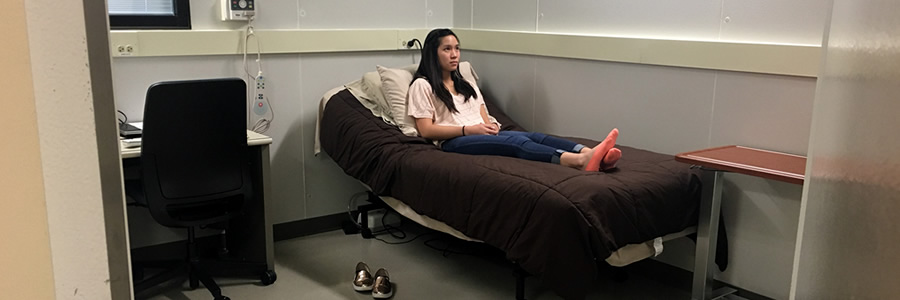A Look Inside a Metabolic Chamber

You can get a great estimate from a fitness tracker on how many calories you burn throughout the day, but to get a more accurate measurement, scientists use a powerful tool called a whole room calorimeter (or a metabolic chamber). Not only can a metabolic chamber give insight into how many calories are burned, but it can also shed light on what kind of calories are being burned, whether they are calories from fat, protein or carbohydrates.
LSU's Pennington Biomedical Research Center is one of a select few institutions
around the world to house not one, but four metabolic chambers. Our scientists use
the chambers to learn more about how different diets, exercise routines, supplements
or other lifestyle factors impact our metabolism.
Gathering this information is vital to the mission at Pennington Biomedical of combatting
obesity and its associated chronic diseases such as cardiovascular disease and diabetes.
Inside Pennington Biomedical's metabolic chambers you'll see a room similar to a dorm room or small hotel room. Each chamber has a bed, a television, a desk with a laptop computer, a sink and a toilet.
Here's how the metabolic chambers work: fresh air is circulated into the room and as it flows out of the room, it goes through a series of analyzers that measures the ratio of carbon dioxide and oxygen in the room. Urine is also collected during a stay in the metabolic chamber to assess protein oxidation. All three measurements—oxygen consumed and carbon dioxide that is breathed out, along with nitrogen—are plugged into a calculation that can give scientists a detailed look at metabolism.
The number of calories a person burns throughout the day depends on their size and activity level. Someone who is smaller and sedentary may burn around 1,200-1,400 calories in a day. The average American burns 2,000 calories a day, although a taller person who weighs more and has more muscle may burn significantly more calories.
During their stay in the metabolic chamber, people spend most of their time relaxing
and doing what they might have spent their downtime doing anyway—watching TV or movies,
reading or playing games online, or talking on the phone. Most stays in the metabolic
chamber are 23 hours long, since it is important to measure or how many calories
are burned during sleep.
"The respiratory quotient—or ratio of carbon dioxide exhaled and oxygen inhaled—during
sleep is a really good measurement for metabolism, since sleep is a time when the
body is conserving energy.," said Dr. Jennifer Rood, associate executive director
of cores and resources at Pennington Biomedical.
At fixed time, a registered dietitian prepares each meal and d and delivers it to the study participant via a small, air-locked cupboard—that way, all the air can be accounted for and scientists can get a more accurate reading on metabolism. Although the room is air tight, the doors of the metabolic chamber are always able to be opened by the person inside, although most people enjoy their restful stay in the chamber.
For researchers at Pennington Biomedical who are working to combat chronic diseases such as diabetes and obesity, metabolic chambers are invaluable and rae instruments.
"We get incredible insight about how the body works from our metabolic chambers—information that we can then use to develop new targets for treating diseases that affect our quality of life. Our ultimate goal is to help people improve their quality and length of life," said Rood.
In Baton Rouge, Pennington Biomedical enlists community volunteers to enroll in a health research study and stay in a metabolic chamber as part of the study.
If you're interested in staying in the metabolic chamber, take a look at the many research studies Pennington Biomedical offers. You can screen yourself online or call 225-763-3000 to talk with someone about which study is right for you.
For more information on how you can support this and other projects at LSU’s Pennington Biomedical Research Center, visit www.pbrf.org.


